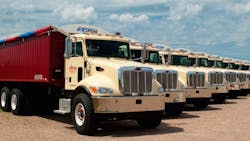How New Oils, Fuels Will Impact Fleet Maintenance
Stricter emission regulations for the trucking industry create new challenges in fleet maintenance. As diesel engines have changed to meet Tier 4 EPA emissions standards, tighter tolerances, greater fuel pressures and higher temperatures of Tier 4 engines place new demands on engine oil and diesel fuel.
The high-pressure common rail direct injection technology in Tier 4 engines generates pressures up to 35,000 psi and internal temperatures exceeding 500 degrees F. Conventional engine oil and diesel fuels break down more quickly under these conditions.
To help protect engines while meeting those performance demands, both fuel and lubricant industries have responded with changes to existing product lines and classifications.
The American Petroleum Institute (API) is creating standards for new oil classes. Proposed Category 11 (PC-11) changes will take effect December 1, 2016, covering API CK-4 and FA-4 diesel engine oils.
“The new oils will provide significantly improved oxidation control, anti-foaming and shear stability protection compared to previous products for existing equipment,” says Andrew Hamilton, technical services and quality manager for Cenex® brand lubricants. “They are also expected to deliver improved lubricity at lower viscosities.”
• API CK-4 oils are expected to be “backwards-compatible” with existing trucks and off-highway engines in current viscosity grades and oil types.
• API FA-4 oils will have lower viscosity grades to improve fuel economy while maintaining durability. These are primarily for 2017 and later fuel-efficient engines and may have limited backwards-compatibility.
Hamilton says the change to better-performing oils will be good for fleet owners, promising not just less maintenance and downtime, but also reduced fuel consumption. Still, some hiccups may occur with the switch.
“The Cenex brand team is preparing to guide customers through the transition and help them find the right oil for each fleet. Viscosity grade trends evolve slowly, so SAE 15W-40 oils are expected to remain the primary viscosity grade for some time. We believe SAE 10W-30 API CK-4 engine oils will see the largest growth first, as they can be used in old and new engines. As fleets modernize, we anticipate they will transition from API CJ-4 to API CK-4, then to API FA-4 for increased fuel economy.”
Premium Fuel Reduces Repairs, Improves Efficiency
Today’s modern fleet vehicles also have fuel-related challenges, especially for fleet owners who use standard #2 diesel. At the high internal temperatures created in Tier 4 engines, typical #2 diesel will cook and start to break down, leaving behind deposits that clog fuel injectors. As vehicles age, fleet owners may notice reduced performance and increased maintenance costs. Power loss, hesitation, slow starts, poor fuel economy and shorter fuel filter life may be warning signs of impending injector failure and expensive repairs.
One easy solution is to use premium fuel formulated for Tier 3 and Tier 4 engine technology. Premium diesel fuel delivers multiple benefits, including:
• Stabilizers that prevent fuel cooking.
• Detergents that keep deposits out of injectors.
• Lubricity additives that protect tight injector tolerances.
“Premium diesel fuel reduces repairs due to clogged fuel injectors or worn fuel pumps. Fleet owners will also see improvements in fuel economy and increased vehicle power and performance,” says Ron Jessen, director of product management, Cenex refined fuels. Cenex Roadmaster XL® premium diesel fuel is formulated with a special additive package for Tier 3 and Tier 4 engines to prevent and remove engine deposits created by #2 diesel.
“We test Cenex premium diesel fuel and lubricants products with CHS Transportation, one of the country’s largest commercial fleets. Our extensive on-road studies have shown reduced maintenance costs and less downtime when using premium fuel paired with high-quality lubricants.”
“We’ve also seen up to 5 percent improved fuel economy with Roadmaster XL, depending on the engine, driving demands and loads pulled,” he adds. “The price difference at the pump might be a few cents more per gallon, but switching to premium diesel fuel can result in operational savings by increasing fuel economy and shrinking repair costs compared to typical #2 diesel.”
Jessen points to a study in Trucking Report, which showed that commercial Class-8 trucks use an average of 20,500 gallons of fuel each year. “A 5 percent fuel savings would amount to about 1,025 fewer gallons of fuel needed. At an average cost of $2 per gallon of diesel fuel, that’s a savings of $2,050 per year for each vehicle.”
For additional information about premium lubricants and fuels for your fleet, visit www.cenex.com.
